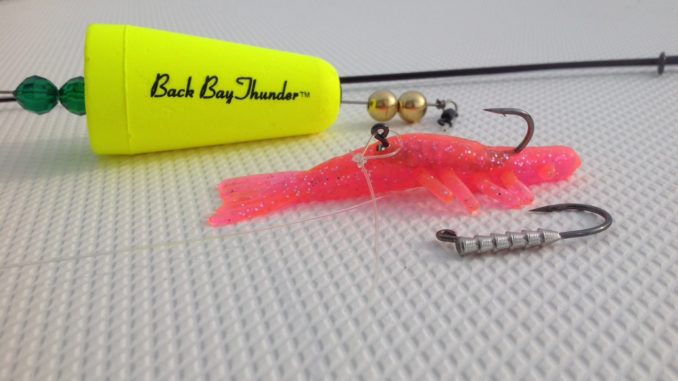
New hook allows fishermen to rig artificial shrimp correctly
Guide Noak Lynk of Harkers Islands has noticed for a while that rigs that use soft-plastic, artificial shrimp, don’t exactly match what nature presents.
“Startled shrimp don’t jump forward, (they) jump backwards,” said Lynk, who runs Noah’s Ark Charters. “Almost every company that makes soft-plastic shrimp or popping and rattling corks offers a version with the shrimp suspended under a float, and all of them use a shrimp with the hook eye at its nose. This arrangement causes the shrimp to move forward quickly when you pop the cork, and that’s not natural.
“till, they catch a lot of fish, so it makes you wonder just how good this combination could be with the shrimp moving naturally.”
Many conversations while fishing led Lynk to look for a hook and weight, or a weighed hook, that could be inserted into the shrimp from the opposite direction, to make it move backward when a cork was popped.
Salty Bay Baits’ pencil hook solved Lynk’s problem. The pencil hook has a shaft weighted to 1/16 of an ounce and a turned-up eye. It’s just enough weight to keep the shrimp upright at rest, while getting it to sink slowly and balance after being popped. Pencil hooks come in 1/0 and 4/0 hook sizes.
“The secret is simply to insert the pencil hook backwards, so the hook point comes out of the shrimp’s head and the eye comes out of its back,” Lynk said. “It will take experimenting just a little to find where the exact balance point is, but when you find it, the shrimp will sink and hang at rest perfectly level.”
Lynk said the 1/0 pencil hook inserts with the curve of the hook coming out the shrimp’s nose. The 4/0 pencil hook is slightly heavier and has a shorter shank, so it comes out of the top of the shrimp’s head, behind the eyes and just in front of the first pair of legs. With both hooks, the eye comes out of the shrimp’s back, just behind the last pair of legs.
“You need to try this to see how well it works,” Lynk said. “Last winter at one of the boat shows, we rigged a couple and dropped them into the bass tank so we could see how they moved and to be sure they sank and hung level. We had to stop because the bass were attacking them. It really does work well.”
Lynk suspends his soft-plastic shrimp 18 to 24 inches under a float on a piece of 20-pound fluorocarbon. The shrimp should be attached with a loop knot for the best action. He likes to cast and let the current carry the sprint past his target, popping it occasionally. When you pop the cork, the shrimp darts backward and then settles naturally and suspends level as a real shrimp would.




Be the first to comment